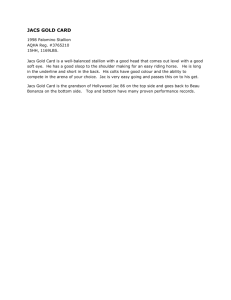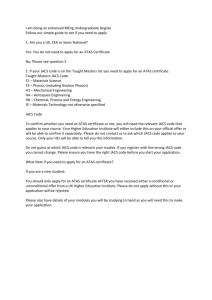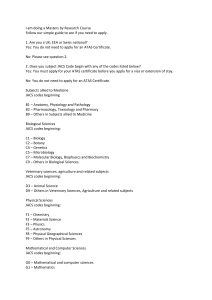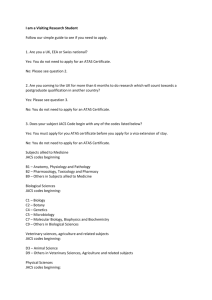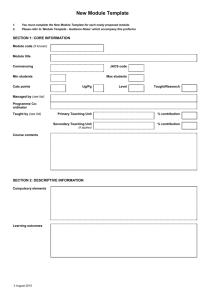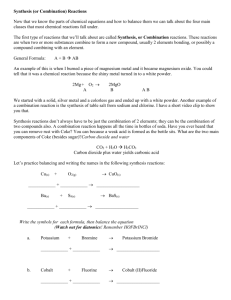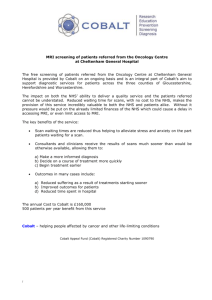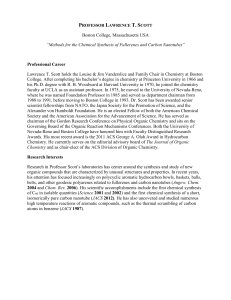Baran Group Meeting Cobalt in Organic Synthesis Klement Foo
advertisement
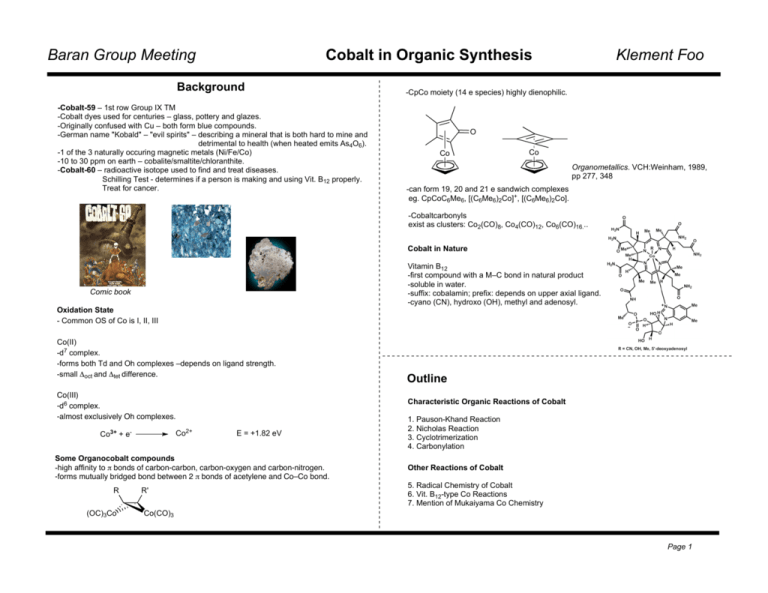
Baran Group Meeting Cobalt in Organic Synthesis Background -Cobalt-59 – 1st row Group IX TM -Cobalt dyes used for centuries – glass, pottery and glazes. -Originally confused with Cu – both form blue compounds. -German name "Kobald" – "evil spirits" – describing a mineral that is both hard to mine and detrimental to health (when heated emits As4O6). -1 of the 3 naturally occuring magnetic metals (Ni/Fe/Co) -10 to 30 ppm on earth – cobalite/smaltite/chloranthite. -Cobalt-60 – radioactive isotope used to find and treat diseases. Schilling Test - determines if a person is making and using Vit. B12 properly. Treat for cancer. Klement Foo -CpCo moiety (14 e species) highly dienophilic. O Co Co Organometallics. VCH:Weinham, 1989, pp 277, 348 -can form 19, 20 and 21 e sandwich complexes eg. CpCoC6Me6, [(C6Me6)2Co]+, [(C6Me6)2Co]. -Cobaltcarbonyls exist as clusters: Co2(CO)8, Co4(CO)12, Co6(CO)16... Cobalt in Nature Vitamin B12 -first compound with a M–C bond in natural product -soluble in water. -suffix: cobalamin; prefix: depends on upper axial ligand. -cyano (CN), hydroxo (OH), methyl and adenosyl. Comic book Oxidation State - Common OS of Co is I, II, III Co(II) -d7 complex. -forms both Td and Oh complexes –depends on ligand strength. -small Δoct and Δtet difference. Co(III) -d6 complex. -almost exclusively Oh complexes. Co3+ + Co2+ e- Characteristic Organic Reactions of Cobalt E = +1.82 eV Some Organocobalt compounds -high affinity to π bonds of carbon-carbon, carbon-oxygen and carbon-nitrogen. -forms mutually bridged bond between 2 π bonds of acetylene and Co–Co bond. R (OC)3Co R' Outline 1. Pauson-Khand Reaction 2. Nicholas Reaction 3. Cyclotrimerization 4. Carbonylation Other Reactions of Cobalt 5. Radical Chemistry of Cobalt 6. Vit. B12-type Co Reactions 7. Mention of Mukaiyama Co Chemistry Co(CO)3 Page 1 Baran Group Meeting Cobalt in Organic Synthesis 1. Pauson–Khand Reaction 1.5 Modifications to Pauson-Khand 1.5.1 'Interrupted' Intramolecular PK – 'insertion of O2' instead of CO 1.1 Mechanistic Outline RL (OC)6Co2 O C RS RL R RL RS (OC)3Co (CO)2Co RL O R O R O O H N H O H N Me OH H O O O O (±)-13-Deoxyserratine (-)-Dendrobine Cassayre Cassayre ACIE 2002, 41, 1783 JACS 1999, 121, 6072 O R O H R or R' H O [5+1]/[2+2+1] H [5+1]/[2+2] Liu, JOC 2006, 72, 567 -If R = Me, heating under CO gives the [5+1]/[2+2+1] adduct; heating under N2 gives [5+1]/[2+2] adduct. If R = H, only [5+1]/[2+2+1] adduct in CO or N2. - reason unclear - speculated to be due to avoidance of quaternary center generation. O Me H R' R = H, Me H O Co2(CO)8 R' H (+)-Epoxydictymene Schreiber JACS 1994, 116, 5505 Krafft, JACS 1996, 118, 6080 heat CO or N2 H H R 1.5.2 Formal [5+1]/[2+2+1] vs. [5+1]/[2+2]-cycloaddition – epoxyalkyne + olefin +CO (OC)5Co2 R R Me OH H heat, air R = CN, (CH2)2OTBS, Et, CH2Ph RS RS 1.2 Pauson–Khand in Total Synthesis H not R O RS (OC)3Co (CO)2Co R O Co2(CO)8 R [2+2+1] RL (OC)3Co (CO)2Co O R RS RL Klement Foo OH Paecilomycine A Danishefsky ACIE 2007, 46, 2199 1.5.3 Sequential Staudinger/PK – Fused Tricyclic β-Lactam Co2(CO)6 R 1.3 Pauson–Khand Readings -S. Gibson, N. Mainolfi, ACIE 2005, 44, 3022 -O. Geis, H. Schmalz, ACIE 1998, 37, 911 -Nakamura, Chem. Rev. 2004, 104, 2127 –TM catalyzed heterocycle syntheses -Buchwald, JACS 1999, 121, 7026 –Ti (in place of Co) Assymmetric PK 1.4 Scope and Limitations -Excellent method for 5-membered ring synthesis – atom economical and has potential flexibility -Long reaction time - addressed by use of tertiary amine N-oxides (xs) to generate free coordination sites at Co by removal of CO ligand. Recent eg. OL 2009, 11, 3104. -Stoichiometric use of Co - addressed with development of catalytic systems, eg. Co2(CO)8/P(OPh)3; indenylCo(cod); Co(acac)2/NaBH4. eg. Photoactivation of Co2(CO)8: JACS 1996, 118, 2285. -Use of other metals - Ru/Ni/Ti - not covered here. -Existing problems: Assymmetric Pauson–Khand, Limited choice of alkyne substrate (terminal). CH(OEt)2 R = H, Me, SiMe3, Ph 1.TMSOTf, ArNH2 2. DIPEA ClOC Ts N n = 1, 2 n R Ar Co2(CO)6 N O N Ts n Bertrand, JOC 2008, 73, 8469 - Pioneered by Alcaide et. al. - [4.6.5] and [4.7.5] tricyclic lactam available Page 2 Baran Group Meeting Cobalt in Organic Synthesis 1.5.4 Asymmetric Pauson-Khand Reaction - 3 approaches: chiral substrates (most common), chiral ligand or chiral amine-oxide promoter. Klement Foo - PNSO ligand works as it is bridging; olefin inserts to Co where S* is bound. - Sterics and higher ! -acidity of sulfinyl ligand favor olefin coordination. Sulfur chirality directs olefin insertion into 1 of 2 Co–C bonds. 1.5.4.1 Chirally-modified substrates in Total Synthesis 2. Nicholas Reaction H H H H (+)-Hirsutene 2.1 Mechanistic Outline O O X OR' H H OR' R' = chiral auxiliary (OC)6Co2 Greene, JACS 1990, 112, 9388 H NR2* Toluene, -30 R1 (OC)3Co *R2N JOC 2000, 65, 7291 1.5.4.2 Chiral amine-oxide promoter - Although modest ee 44%, first innovative use of chiral amine N-oxide. - can use achiral reagents 1.5.4.3 Chiral Ligands - Large number of studies in this field: one major challenge remains – use of symmetrical alkynes. - Symmetrical alkynes less reactive; chiral phosphine ligand too far away to direct olefin insertion, thus end up with an almost racemic product. R1 LA Co(CO)3 O N P S O Tol OC Co Co CO OC CO R [O] Nu- (OC)3Co Co(CO)3 R1 Nu (OC)3Co Co(CO)3 2.2 Scope 2.3 Readings on Nicholas Reaction - Named reaction in Organic Synthesis - for a brief introduction. - JACS 1998, 120, 900 - for Phys Org study on electrophilicity of propargylium ions and compatible nucleophiles. 2.4 Nicholas Reaction in Total Syntheses OR O OBn H H H NH O R NMO, rt, CH2Cl2 R H ee >90% Riera, OL 2009, 11, 4346 ß-Lactam Precursor to thienamycin Jacobi JOC 1996, 61, 2413 H H O Me(H2C)4 i–Bu R R1 - Reactions of propargyl halides with ! -systems required >1 alkyl or Ph substitutents EDGs ==> limited use of propargyl cation as synthons. - Dicobalt hexacarbonyl group efficiently stabilizes the cation. (also used as alkyne PG) - SN1 type reaction - Thermodynamic control (Lewis acid catalyzed). Kerr, Synlett 1995, 1085 Ar Ar X O oC 2. [O] R1 For similar total syntheses see JOC 1995, 60, 6670 and JOC 1996, 61, 9016. Using chiral substrates - in this case a chiral ynamine Nu 1. Nu- H O O O HO (+)-Secosyrin 1 Mukai JOC 1997, 62, 8095 O H H (+)-Epoxydictymene Schreiber JACS 1994, 116, 5505 Page 3 Baran Group Meeting Cobalt in Organic Synthesis Klement Foo - Tricyclic ethers: [5.6.5] and [5.9.5] poor yield; [5.7.5] and [5.8.5] trans favored; [5.10.5] not isolable - dimerizes to give 20-membered-ring. - Tricyclic amines: [5.7.5] gives excellent cis selectivity; [5.8.5] cis favored; others not favored. - Tricyclic lactones: not successful; also dimerizes to give diolides (ThD controlled). Also featured in JOC 2005, 70, 9088. 2.4.1 Total synthesis of Velloziolide - Benzo-fused ε−lactone unit - 1st synthesis. - Derived propargyldicobalt cation stable despite the EWG (CO2Me). - Use of 2 Nicholas reactions. CO2Me O MeO O O O Co2(CO)6 1. Bu2BOTf O MeO2C 2. [O] 1. Rh/C, MeOH 2. MeLi O 2.6 Using ThD to advantage R HO BnO OH Li O BnO R 1. Co2(CO)8 2. cat. TfOH 3. Et3N, I2 R HO OH Nicholas OBn CO2Me O MeO O BF3–OEt2 CO2Me Inouye, OL 2003, 5, 625 - Mitsunobu conditions not α/β selective. - Nicholas gives high β−selectivity since ThD conditions cause epimerization of α anomer to β counterpart. 2. [O] Nicholas O O OR O MeC(OEt)3 EtCO2H O 1. BCl3 2. AgNO3 O OBn R = SiMe3: β/α > 99 1. Me2CuLi 2. DIBAL-H O 3. [2+2+2] Cyclotrimerization with Co O 3.1 Mechanistic Outline R = CH2Cl2 R=H OH velloziolide Green, JOC 2009, 74, 7411 L LnM -L LnM L -L LnM L LnM R 2.5 Tandem Intramolecular Nicholas/PK for Synthesis of Tricycles MLn LnM R d.r. dependent on reaction conditions O Z n OMe Co2(CO)8 N.B. Bond angle reduced to 138º H OMe n LnM 3.3 [2+2+2] Cyclotrimerization with Co in Total Syntheses O (OC)6Co2 Nicholas Z R - Catalytic Co (usually CpCo(CO)2). - Other metal alternatives such as Rh, Ru, Ir and Pd. - Used widely to create complicated polycycles. H PK (OC)6Co2 +2 R LnM 3.2 Scope and Limitations H Z n = 1 – 10 coordination to satisfy 18 e- rule R R - Endocyclic cyclization is one of the least studied. Endocyclic cyclization using alcohol, amine and carboxylic acid as nucleophiles are studied here, where the latter two are unprecedented. R R "template" n R R CO2Me H O OBn O Co2(CO)6 1. Bu2BOTf BnO N H H Z n Shea, JOC 2008, 74, 3680 H HO H Oestrone Vollhardt JACS 1979, 101, 215 N H H O O (±)-Strychnine Vollhardt OL 2000, 2, 2479 Page 4 Baran Group Meeting Cobalt in Organic Synthesis Other Total Syntheses: - Diterpene: Illudol – JACS 1991, 113, 381. Stemodin – JACS 1991, 113, 4006. - Fullerodendrimers – ACIE 2007, 46, 951. - Helicenes – ACIE 2008, 47, 3188. JOC 1998, 63, 4046. JOC 2007, 73, 2074. - A DFT Study – JACS 2006, 128, 8509. SiMe3 SiMe3 Me3Si Me3Si Klement Foo - Commercial production of butyraldehyde from propylene. Butyraldehyde used to make butanol (2.1 × 106 ton/yr), 2-ethylhexanol (3 × 106 ton/yr), etc. - Rh catalyst has replaced Co (higher selectivity and stability). 4.2 Hydrocarboxylation cat. heat RCH=CH2 + CO + HX RCH2CH2COX SiMe3 X = OH, OR, SR, NHR, etc SiMe3 ACIE 1995, 34, 1478 4.3 Amidocarbonylation 3.4 Cobalt (I)-mediated [2+2+2] of Allenediynes Ph O 1. CpCo(CO)2 xylene, 300W heat NHCOR' RCH=CH2 + R'CONH2 + 2CO + H2 RCH2CH2CHCOOH - Via aldehyde intermediate. ACIE 2000, 39,1011 - Used in the synthesis of aspartame, sarcosinates, etc. O Ph 2. SiO2, CH2Cl2 48% 4.4 Hydrosilylcarbonylation Available in 6 steps HSiEt2Me 11 β-aryl steroid OSiEt2Me + CO Aubert, OL 2004, 6, 3937 - ABC ring system generated in 1 step. However stoichiometric Co needed. 4.5 Carbonylation of halides CH2Cl 3.5 [6+2] Co(I)-mediated Cycloaddition R CO CoI2(dppe)/Zn/ZnI2 4.6 Hydroaminomethylation 43–96% R NH3 Buono, OL 2005, 7, 2353 4. Carbonylation - Organocobalt used as catalyst in these reactions. 4.1 Hydroformylation 2HCo(CO)4 RCH=CH2 + CO + H2 -2CO HCo(CO)3 active species cat. RCH2CH2CHO 100 ºC 100 atm CO/H2, Co cat. HN H2N Chem. Rev. 1999, 99, 3346 - Over alkylation over. Co phased out due to large amounts of byproducts such as formamides, hydrogenation products and alcohols. - Rh used widely for hydroaminomethylation of olefins, diolefins... - A wide range of R groups applicable. Catalytic system tolerates ketone, sulfone, ester, ketal, ether, alcohol, imide and nitrile. Co2(CO)8 + H2 CH2COOMe MeOH Omae, AOC 2007, 21, 318 4.7 Hydroazidation - the new hydroamination? - Hydroamination – La and early TM catalysts effect intramolecular hydroaminations. Late TM prefer Michael acceptors as substrates or activated olefins for intermolecular hydroamination. Lack of general hydroamination procedure. - Azide a good nitrogen sources, as it can be converted to amines easily. - Traditional methods require SN of 1º or 2º halides with azides/ or alkenes (those able stabilize carbocation) with TMSN3 or NaN3. - Hydroazidation is a catalytic process which enables functionalization of unactivated olefins with high Markovnikov selectivity. Page 5 Baran Group Meeting Cobalt in Organic Synthesis Ph Ph N CO2K t–Bu OH R1 R3 TsN3 R2 6 mol % t–Bu - Limitations include the use of expensive GR in excess. Use of GR also limits substrate functionalities. t–Bu O R3 R1 6 mol %Co(BF4)2•6H2O 30 mol % t–BuOOH, silane EtOH, 23 ºC N t–Bu R3 Ph Ph H N3 Co Klement Foo Ln O O generated in-situ 5.1.1 Intramolecular Heck-type Reaction of 6-Halo-1-hexene R1 X I R3 Careira, JACS 2005, 127, 8294 R2 cat. CoCl2(dppb) Me3SiCH2MgCl (1.5 eq) X R1 R2 R3 JACS 2001, 123, 5374 OL 2002, 4, 2257 JACS 2006, 128, 8068 - No precedence observed with Pd catalysts. Prior studies required stoichiometric cobaloximes and irradiation. - Radical generation; 5-exo-trig; Co-trap; ß-H elimination. 5.2 Cross-Coupling of Aryl GR with 1º and 2º Alkyl Bromides ArMgBr (1.2 eq) R–I CoCl2 R–Ar NMe2 JACS 2006, 128, 1886 NMe2 - Also see hydrohydrazination: JACS 2004, 126, 5676 and OL 2005, 7, 4249. - Great review on both processes: JACS 2006, 128, 11693. - Next question to ask: Asymmetric hydroazidation? - Applied in the total synthesis of AH13205 - Recently, another group published the chemoselective alkylation of Aryl GR using alkyl bromides/iodides and Co(acac)3/TMEDA as catalysts. TMEDA cheaper than N,N,N',N'-tetramethyl-1,2-cyclohexanediamine – Cahiez, OL 2009, 11, 277. 5.3 Radical Dimerization - Radical dimerization has been used in a number of total syntheses. 5. Radical Chemistry of Cobalt 5.1 "Heck"-like coupling with Cobalt Me H R N O Me N 5.1.1 Strylation of alkyl halides R–X R – normally long alkyl X – usually Br Ar cat. [CoCl2(dpph)] Me3SiCH2MgCl (2.5 eq) Me N R Ar Oshima, JACS 2002, 124, 6514 JACS 2006, 128, 8068 - Pd catalyzed Heck coupling experience ß-H elimination when alkyl halides are used as substrates. Alkyl halides also have slower oxidative addition rates. - Ni catalyzed versions afford moderate yields. Not as eco-friendly as Co. - This Co reaction involves SET resulting in alkyl radical generation which adds to styrene, propagating a new stabilized radical. This radical is then trapped by Co and subsequent ß-H elimination yields product. N R H Me R = H; (+)-chimonanthine R = Me; (+)-folicanthine Movassaghi ACIE 2007, 46, 3725 N H H N H O S N S N O N H H S N S O O Me O O Me O (+)-11,11'-Dideoxyverticillin A Movassaghi Science 2009, 324, 238 H (+)-Biatractylolide Baldwin JOC 2004, 69, 9100 - Reductive dimerization employed in all syntheses using ClCo(PPh3)2 as stoichiometric reagent. Page 6 Baran Group Meeting Cobalt in Organic Synthesis - Wide range of terminal epoxides can undergo HKR followed by 1,2-diol ring opening with water as stiochiometric nucleophile. Complements OsO4 dihydroxylation. - Double resolution performed if high ee are needed. - >99 % ee and >40% yield. - Relatively cheap catalyst and recyclable with low-boiling substrates. Solid residue from distillation can be reoxidized to Co(III) with no loss of reactivity or selectivity up to 6 cycles. - ClCo(PPh3)3 was actually used in preceding literature for dimerization of allylic halides. - Typical reaction coonditions are mild and non-basic. Reaction proceeds with preservation of stereochemistry. Cl O O H N O Co N O H - It was found that oligomers of Co cat. gave higher ee. - Eg. asymmetric hydroxylation of cyclohexene oxide difficult with monomeric (salen)Co(OAc) but effective with oligomeric (salen)Co(OTs) (>94% ee) using water as nucleophile. - Alcohols can also be used as nucleophiles in this protocol. Cl O Yamada, TL 1983, 24, 921 Klement Foo O t–Bu t–Bu t–Bu t–Bu H O N Co O N H - Coupling of benzylic halides was also reported – CL 1981, 1277. O O Why ClCo(PPh3)3? R1 n = 1-5 Me O N CN O H Me N N Co Me N O N OH H Me O CN Bis(dimethylgloximato)cobalt(III) Co N N O t–Bu t–Bu (Salen)Co(II) "Jacobsen" Square planar 4 coordinate Forms an axial Co–C bond. Co Cl ± (S,S) (salen)Co(III).OAc Cl >99% ee O O R OH O Me OH JACS 2009, 131, 2786 Me Bis(acetylacetone)ethylenediamine (BAE)-type cobalt "Yamada" -Used widely in enantioselective borohydride reduction, cyclopropanation, hetero Diels-Alder, Henry reaction... - For a detailed mechanistic study on HKR of epoxides, see JACS 2004, 126, 1360. 6.3 AKR of Terminal Epoxides - Useful tool for preparation of optically active N-protected1,2-amino alcohols. - Use of carbamates as nucleophiles. rt in air. NH2R (1 eq) (R,R) O (salen)Co(III).OAc O N 6.2 HKR of Terminal Epoxides with (salen)Co(III) complexes O O Me Me t–Bu t–Bu N R H OH R1 - Both monomeric or oligomeric (salen)CoOTf successful in intramolecular oxetane ring opening. achiral reagents to optically active products. - depending on the tether, quaternary stereocenters can be formed. 6.1 Some Co compounds with vitamin B12 character H (R,R)-cat. LPTS JACS 2001, 123, 2687 ACIE 2002, 41, 1374 Cl 6. Vitamin B12-like compounds H R2 O O Cl Me HO OH O OH Cl OH >99% ee R1 (2.2 eq) OH (R,R)-cat. p-nitrobenzoic acid TBME (5M) R1 NHR >99% ee Bartoli, OL 2004, 6, 3973 Science 1997, 129, 1105; JACS 2002, 124, 1307 Page 7 R2 Baran Group Meeting Cobalt in Organic Synthesis 6.4 Enantioselective Nitro-Aldo (Henry Reaction) using self-assembled (salen)Co(II) - Self assembly of novel dinuclear (salen)Co(II) catalyst using non-covalent H-bonds (proved by X-ray structure). - Applied system to Henry reaction in anhydrous solvent CH2Cl2 (essential). - monomeric species gave modest %ee and yields. Ar CH3NO2 (10 eq) H - The resultant O-benzyloxime or oximonitrile can be converted into the corresponding aldehyde by hydrolysis with formaldehyde and cat. HCl. 7. A Mention of Mukaiyama Co Chemistry 7.1 Mukaiyama 'Oxidation-Reduction' HydrationOOSiEt 3 Et3SiH cat. DIPEA CH2Cl2 O Klement Foo OH NO2 Ar R O2, Co(acac)2 R OH PhSiH3 82–96 % ee X R2 or Co(BF4)2.6H2O ligand, t–BuOOH, PhSiH3, EtOH R2 R1 OH t–Bu O N 7.3.1 Total Synthesis of (–)-mucocin HO O O X = H, CN OH O O OH N OBn same cat. CL 1990, 67 O 9 X PhSiH3 EtOH, RT O modp = OBn X OH trans O OK 6.6 Salen-type Co Reductive C–C Bond Forming Reactions S O O Careira, ACIE 2008, 47, 5758 Ph CL 1989, 2005 t–BuOOH, i–PrOH - Used TsCl as a Cl source. - First protocol optimal for 1,1-disubstituted olefins or electron poor olefins. Second protocol optimal for monosubstituted olefin. Mechanism analogous to hydroazidation (see before). - Similar hydrocyanation see ACIE 2007, 46, 4519. (Avoids use of HCN). Ph R O2, Co(modp)2 t–Bu N X OH H Cl N N Co O O N t–But–Bu HO 7.3 Oxidative Cyclization of 5-hydroxy-1-alkenes with O2 R3 Ph Ph t–Bu t–Bu H3O+ X = CN, CONR2, COOR Co cat., PhSiH3, EtOH TsCl 1. cat. CoL2, PhSiH3 2. 6.5 Salen-type Co hydrochlorination + CL 1989, 1071 7.2 Preparation of α,β-nitriles, amides and esters RCHO R3 H R Hong, JACS 2008, 130, 16484 R1 H OH (–)-Mucocin P. Evans JACS 2003, 125, 14702 O O 1 TBSO Ph Careira, JACS 2009, 131, 13214 9 O 2 5 O OH OPMP 3 OHC O O 4 Page 8 Cobalt in Organic Synthesis Baran Group Meeting TBSO O 9 2 5 O OH OPMP O OHC 3 4 O O O 6 OH 5 O 1. Mitsunobu inversion OH 5 OH Co(modp)2 HO O2, t–BuOOH 2. AllylMgBr OPMP O OPMP 8. What I could not cover - Cyclization with Co – [2+2]; [3+2]; [5+2] cyclizations - Oxidation with Co - 1,4-Reduction with Co - Radical Chemistry of Co - Use of Co in Living Radical Polymerization of Vinyl Acetate/Isoprene - Yamada Co Chemistry - 9. Conclusion - Observation: most seminal studies began with Co as choice of metal. However, Co is replaced by other metal alternatives, mainly Rh and Ru. - Room for development: Instead of working on reactions which currently use Co, such as PK or Nicholas reaction, maybe the focus should be on replacing other metals with Co. Respect the Co!!! Klement Foo
